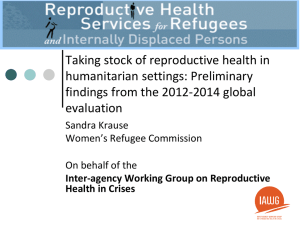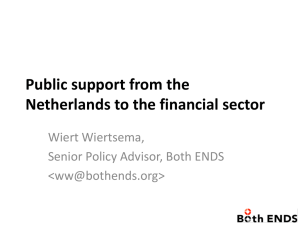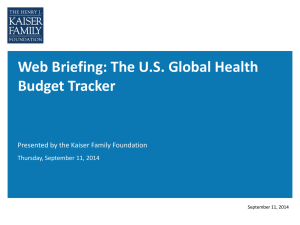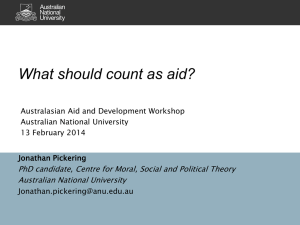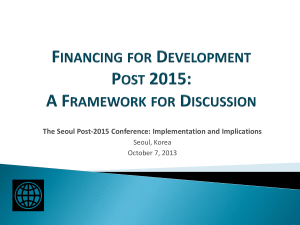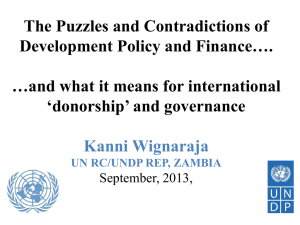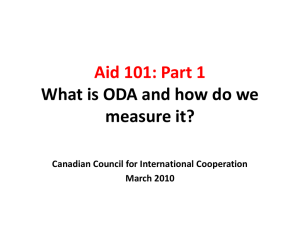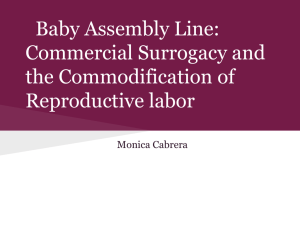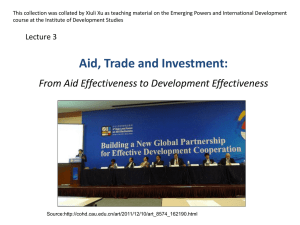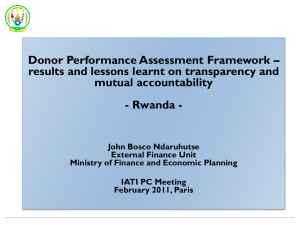Document 5465916
advertisement
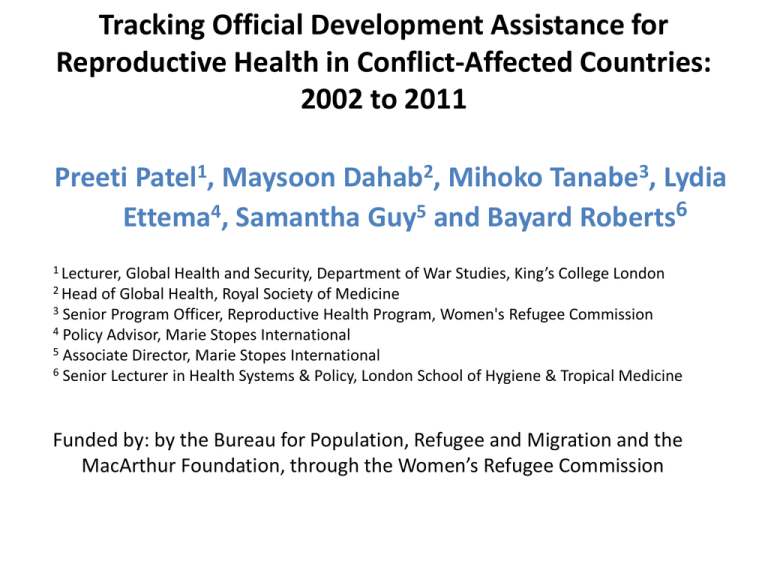
Tracking Official Development Assistance for Reproductive Health in Conflict-Affected Countries: 2002 to 2011 Preeti Patel1, Maysoon Dahab2, Mihoko Tanabe3, Lydia Ettema4, Samantha Guy5 and Bayard Roberts6 1 Lecturer, Global Health and Security, Department of War Studies, King’s College London of Global Health, Royal Society of Medicine 3 Senior Program Officer, Reproductive Health Program, Women's Refugee Commission 4 Policy Advisor, Marie Stopes International 5 Associate Director, Marie Stopes International 6 Senior Lecturer in Health Systems & Policy, London School of Hygiene & Tropical Medicine 2 Head Funded by: by the Bureau for Population, Refugee and Migration and the MacArthur Foundation, through the Women’s Refugee Commission Research Purpose and Objectives Purpose: To provide longer-term trends in patterns of ODA disbursement for RH activities in 18 conflict-affected countries from 2002 to 2011 Objectives 1. To measure absolute & per capita amount of RH ODA to 18 conflict-affected countries 2. To compare RH ODA disbursed to conflict-affected countries and non-conflict affected countries 3. To analyse disbursement patterns of RH ODA across different RH-related activities 4. To analyse disbursement patterns of RH ODA across donors Methodology Data Source • Creditor Reporting System (CRS) maintained by Development Assistance Committee (DAC) of the Organisation of Economic Cooperation and Development (OECD) – http://stats.oecd.org/Index.aspx?datasetcode=CRS1 – Covers 100% of all ODA to developing countries including conflict-affected countries – Used in other tracking studies (see refs) – Reporting is mandatory for donors (using standard criteria) – 26 bilateral donors and 18 multilateral donors Sampled Countries: Afghanistan, Angola, Burundi, Central African Republic, Chad, Colombia, Democratic Republic of Congo, Eritrea, Iraq, Liberia, Myanmar, Nepal, Sierra Leone, Somalia, Sri Lanka, Sudan, East Timor, Uganda Inclusion Criteria: In war at a point between 2000-2009 (Uppsala definition) so includes post-conflict Data Analysis • CRS data for 2002-2011 for aid disbursements for 18 conflict-affected countries • All ODA data for each recipient country downloaded from the CRS database and analysed in Stata and Excel • CRS purpose codes • Comparative analysis with non-conflictaffected ‘least developed countries’ CRS activities included Direct activities % allocated Indirect activities % allocated Population policy & admin. Management 100 Primary education 10 Reproductive health care 100 Basic skills for youth and education 10 Family planning 100 Early childhood education 10 Personnel d’ment for population & RH 100 Secondary education 10 Social mitigation of HIV/AIDS 100 Health policy & admin. Management 10 HIV/AIDS and STD control 100 Basic health care 25 Basic health infrastructure 25 Basic nutrition 75 Health education 25 Health personnel development 25 General budget support 2 Material relief assistance and services 2 Reconstruction relief and rehabilitation 2 Results: Objective One Absolute ODA for reproductive health to conflict-affected countries 1400 1200 US $ ODA (millions) 1000 800 600 298% increase 400 $1.93 per capita per year 200 0 2002 2003 2004 2005 2006 2007 2008 2009 2010 2011 Results: Objective Two Compare RH ODA between conflict-affected countries and non-conflict-affected countries Average annual per capita RH ODA $4.00 $3.60 $3.50 $3.00 US $ $2.50 $2.30 $2.00 $1.50 $1.00 $0.50 $0.00 conflict-affected LDCs non conflict-affected LDCs Results: Objective Two – cont. Disbursement of RH between 18 sampled conflict-affected countries • Uganda ($8.1), Timor-Leste ($6.7) and Liberia ($5.4) receive highest RH ODA per capita • Colombia ($0.2), Myanmar ($0.4) and Sri Lanka ($0.7) receive the least RH ODA per capita • Despite worse health indicators, Chad ($1.9 per capita) and Somalia ($1.5 per capita) get less RH ODA per capita than East Timor ($6.7 per capita) 1.5 Maternal mortality and reproductive health care ODA Timor-Leste Sierra Leone Liberia 1 Afghanistan .5 Eritrea Nepal Burundi 0 Sudan Sri Lanka Colombia Myanmar Iraq 0 Chad CAR DRC Somalia Angola 500 1000 1500 Maternal mortality (per 100,000 live births) *consists of just the CRS purpose code of reproductive health care 2000 Results: Objective Three 1400 1200 Distribution of reproductive health ODA to conflict-affected countries 2002-2011, by activity (US$ million) ODA (USD$ millions) 1000 800 600 400 200 0 2002 2003 2004 2005 2006 2007 2008 2009 2010 Indirect activities STD control, including HIV/AIDS Social mitigation of HIV/AIDS Reproductive health care Family Planning Population policy and administrative management Personnel development for population and RH 2011 Results: Objective Four RH ODA disbursement by donors • Main bilateral donors (absolute amounts) – USA, Japan, Germany and UK • Main bilateral donors (proportional) – Ireland, Denmark and Iceland • New donors – Czech Republic, Korea and UAE • Main multilateral donors (absolute amounts) – World Bank and EU • Gates Foundation - Total Gates RH ODA to conflictaffected countries 2009-2011: $2.88 million - average annual RH ODA per capita = $0.000002 Limitations General • ODA to countries rather than specific conflict-affected regions within country • national expenditure data not included • donor disbursement data rather than actual expenditure CRS • No purpose code for GBV • Can’t determine beneficiaries of ODA • Not all donors report to CRS • Data completeness and accuracy • Descriptive project information sometimes missing • Time lag Key messages 1. Substantial increase (298%) in ODA funding for reproductive health activities to the 18 conflict-affected countries between 2002 and 2011. 2. Majority of the increase in overall reproductive health funding is explained by increased ODA for HIV/AIDS activities 3. Inequity in funding between conflict-affected countries – winners and losers 4. Inequity in funding between conflict-affected countries and non-conflictaffected least developed countries – conflict-affected countries losing out 5. Gates funding for reproductive health for conflict-affected countries is negligible 6. $1.93 per person per year seems very low but we don’t know what the funding gap is? 7. Need for detailed analysis of in-country RH ODA expenditure – who is benefitting? 8. Need to better understand the relationship between ODA investment and changes in RH outcomes References Patel, P., et al., Tracking official development assistance for reproductive health in conflict-affected countries. PLoS Med, 2009. 6(6): p. e1000090. Patel, P. and B. Roberts, Aid for reproductive health: progress and challenges. Lancet, 2013. 381(9879): p. 1701-2. Patel, P., et al., A review of global mechanisms for tracking official development assistance for health in countries affected by armed conflict. Health Policy, 2011. 100(2-3): p. 116-24. Spiegel, P.B., N. Cornier, and M. Schilperoord, Funding for reproductive health in conflict and post-conflict countries: a familiar story of inequity and insufficient data. PLoS Med, 2009. 6(6): p. e1000093. Hsu, J., P. Berman, and A. Mills, Reproductive health priorities: evidence from a resource tracking analysis of official development assistance in 2009 and 2010. Lancet, 2013. 381(9879): p. 1772-82. Warsame, A., P. Patel, and F. Checchi, Patterns of funding allocation for tuberculosis control in fragile states. Int J Tuberc Lung Dis, 2014. 18(1): p. 61-6.
